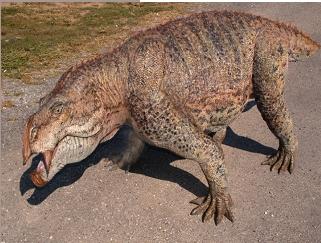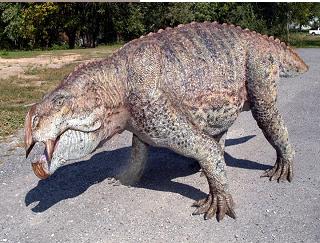click images for larger views
Placerias was a sturdy animal with tusks for rooting through the soil in search of a range of vegetation, and a beak for uprooting plants. A low-slung, powerful animal resembling a hippopotamus, Placerias was not a dinosaur, but a dicynodont or "two-tooth dog". It was so called because it had toothless jaw margins with only the two canine teeth, near the front. Dicynodonts are therapsids, or mammal-like reptiles, a group that includes the ancestors of modern mammals.
The best fossil find was at the Petrified Forest at St Johns, Arizona in the USA, where forty individuals were identified.
Some paleontologists believe there is evidence that Placerias lived in a seasonal environment. Wear patterns on the tusks of other dicynodonts show alternate deep grooves and a smoother polishing effect. In the dry season they would have dug hard earth, which scarred the tusks. In the wet season, the ground would be wet and silty, helping to polish them.
The best fossil find was at the Petrified Forest at St Johns, Arizona in the USA, where forty individuals were identified.
Some paleontologists believe there is evidence that Placerias lived in a seasonal environment. Wear patterns on the tusks of other dicynodonts show alternate deep grooves and a smoother polishing effect. In the dry season they would have dug hard earth, which scarred the tusks. In the wet season, the ground would be wet and silty, helping to polish them.
Placerias
Pronunciation: plah-SEE-ree-ass
Meaning: Mammal-like reptile
Animal Type: Herbivore - club moss, low-level ferns, roots and tubers
Size: Up to 3.5 metres long
Weight: Up to 1 tonne
Fossil Finds: USA
Pronunciation: plah-SEE-ree-ass
Meaning: Mammal-like reptile
Animal Type: Herbivore - club moss, low-level ferns, roots and tubers
Size: Up to 3.5 metres long
Weight: Up to 1 tonne
Fossil Finds: USA
[News] [Life-Size Sculptures] [Model Kits] [Wildlife Collection] [Complete Catalog] [About Us] [Contact Us]
[Frequent Questions] [The Studio At Work] [Links] [Privacy Policy] [Terms of Use]
© 2017 CM Studio
All Rights Reserved
CM Studio 100 West Central Avenue Benld, Illinois 62009
mail@cmstudio.com
[Frequent Questions] [The Studio At Work] [Links] [Privacy Policy] [Terms of Use]
© 2017 CM Studio
All Rights Reserved
CM Studio 100 West Central Avenue Benld, Illinois 62009
mail@cmstudio.com


